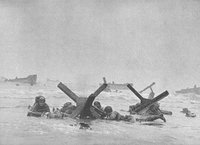Cheval de frise
|
|
GlassCheval_de_Frise.JPG
The cheval de frise (plural: chevaux de frise) was a Mediaeval defensive obstacle consisting of a portable frame (sometimes just a simple log) covered with many long iron or wooden spikes or even actual spears. They were principally intended as an anti-cavalry obstacle but could also be moved quickly to help block a breach in another barrier. They remained in occasional use until they were replaced by wire obstacles just after the American Civil War.
The term also came to be used for any spikey obstacle, such as broken glass embedded in mortar on the top of a wall.

A variation of the chevaux de frise are Czech hedgehog anti-tank obstacles, typically composed of three rails, crossed in such a way that they form a six-spiked figure, possibly sealed in concrete or partly buried in sand or earth (very much like a metal abatis). They can be mined. The Atlantic Wall used millions of such obstacles to slow down landing of armoured and mechanised troops, as to make them easy targets for machine guns and coastal artillery.
Etymology: Cheval de frise is French for "Frisian horse". The Frisians, having little cavalry of their own, relied heavily on such anti-cavalry obstacles.
See also
Knife_rest.jpg
